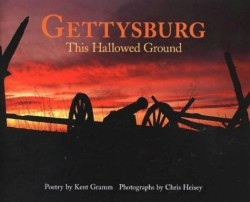
Gettysburg
This Hallowed Ground
“Can the mayhem and cruelty that are war be made into something both beautiful and honest?” asks the author in his introduction. If judged by the photographer’s resplendent works and Gramm’s meditative verse, the answer is a resounding yes.
Visitors to the Gettysburg battlefield invariably express awe at the resonant spirit emanating from the fields and gently rolling hills where 165,000 Union and Confederate troops collided in three days of carnage in July 1863. In a skillfully blended marriage of photographs and poetry, this volume captures Gettysburg’s haunting beauty while also paying homage to the sacrifice, bloodshed, and loss of the 50,000 soldier and civilian casualties.
Heisey specializes in photographing the nation’s battlefields; he has visited Gettysburg 1,200 times. He has photographed the park in all seasons and at all hours, from the searing 104-degree heat of a July afternoon to the 23-degrees-below-zero cold of a winter’s night. His fascination for the 1,400 statues and monuments scattered over Gettysburg’s 6,000 acres, coupled with his mastery of light and shadow, create vivid, unforgettable images of this one-of-a-kind landscape.
Heisey sought out Gramm to write the verse to accompany his photographs. Of their partnership, Heisey says, “I knew of no other writer who expressed in words what I have tried to express with my imagery.”
Gramm, a professor of English and creative writing at Wheaton College in Illinois, is also the author of Gettysburg: A Meditation on War and Values, and several other books that mingle history with his personal philosophy. His poems are spiritual reflections and, as in “The Twenty-third Psalm,” summon divinity to provide solace and healing: “for the agony that was Gettysburg. / If when the pain is over He anoints / my head and fills my cup, I shall look back. / The valley of the shadow shall lie quiet: / while streams of soldiers, resurrected, bear / praises, thanksgivings, ascending to / forgetful rooms and halls of never, never— / to dwell in the House of the Lord forever.”
Although Gramm’s verse is unabashedly devout, (in “A Chapel on a Hill,” “Transfiguration,” and “The End of the World,” profoundly so,) he displays a religiosity that both Union and Confederate soldiers of the Civil War would have welcomed. Gramm’s language, sentiments, and romantic imagery are steeped in nineteenth-century Protestant Christian culture, reflecting an era when religion was at the heart of American culture and was the predominant force in people’s lives.
Though Christian readers will especially appreciate the verse, Civil War buffs and visitors to Gettysburg will be amazed at how Heisey’s photographs seize the marrow of the Gettysburg experience.
Disclosure: This article is not an endorsement, but a review. The publisher of this book provided free copies of the book to have their book reviewed by a professional reviewer. No fee was paid by the publisher for this review. Foreword Reviews only recommends books that we love. Foreword Magazine, Inc. is disclosing this in accordance with the Federal Trade Commission’s 16 CFR, Part 255.
